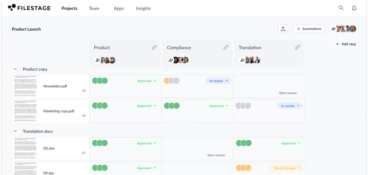Today’s fast-paced world calls for both quality and quantity when creating content. No pressure, eh?
The good news is, if you’re looking for ways to boost productivity and deliver top class content in a flash, this is the article for you. Because today I’m going to let you in on 10 of the best creative automation tools.
Here’s the roundup of the best creative automation tools:
- Hunch
- Celtra
- Filestage
- Flaminjoy
- Bannerflow
- Marpipe
- Mailchimp
- Innervate
- Pikelixe
- Bynder
Before we take a closer look at the most creative automation tools, let’s see what creative automation actually is and how it can help businesses like yours stay ahead of the game.
What is creative automation?
Creative automation is the process of using technology to streamline and speed up the creation and delivery of all kinds of content, including graphics, videos, and different marketing materials. It’s a marketing approach that can help bridge the gap between the amount of content teams need to produce and the resources they have at hand.
Automating parts of your creative process often involves the use of algorithms, templates, and predefined rules for workflow automation – or to make new variations of content. For example, graphic designers can manually create one design or template and use it to generate new versions or formats with creative automation tools.
Let’s check out some of the biggest benefits of creative production process!
Efficiency
Creative automation solutions can significantly reduce the time and effort it takes to create content. With the right automation tools, repetitive tasks can be performed quickly, giving creative teams the time and space to focus on more strategic aspects of their work.
Scalability
Automation allows for the production of large volumes of content in a relatively short amount of time. This can be especially useful for businesses with diverse product lines or multiple marketing channels.
Consistency
By using templates and predefined rules, creative automation ensures brand consistency across various pieces of content while taking away the risk of human error. This also makes it easier to maintain brand consistency across visuals and messaging alike.
Cost-effectiveness
Automating repetitive tasks is good for businesses’ wallets as it reduces the need for manual labor. So, creative automation tools can often cost less to run compared to traditional methods of content creation.
Increased job satisfaction
Creative automation software takes away unnecessary stress and time pressure brought on by jam-packed workloads. Cutting the amount of repetitive tasks your team has to carry out can also support creative collaboration and make the job more enjoyable as a whole.
What creative processes can teams automate?
These days, most routine tasks can be taken care of by AI and creative automation. But there are other aspects of the creative process where creative automation solutions can come in handy, too!
Below, you’ll find four common use cases for creative automation.
Graphic design and visual content creation
A lot of creative automation tools are equipped with templates and design elements that can automate the way you create graphics and other visual content for social media posts, blogs, and email newsletters. This reduces the need to manually create different versions of content every time.
Automated image editing software can also enhance and modify images automatically, saving more time on manual editing tasks, too.
Social media management
Automation platforms can schedule posts across various social media channels, ensuring consistent engagement with your audience without needing to manually post at specific times.
AI-powered tools can then often analyze social media trends and user behavior, providing extra insights for content optimization and personalized messaging.
Email marketing
Automated email marketing platforms can segment your audience based on demographics, behavior, or engagement level. This allows for more targeted and personalized email campaigns that your audience will love.
You can also use automation to optimize email subject lines, content, and send times based on historical data and A/B testing results for stronger open and click-through rates.
Workflow automation
Taks automation tool can optimize content creation processes by assigning tasks to team members based on predefined criteria such as skills, availability, or workload. These automated systems track the progress of each task, sending reminders for deadlines and escalating issues as needed, thereby ensuring efficient workflows and creative project management.
Additionally, automation tools streamline approval processes by carrying content through the right channels and notifying stakeholders when content is ready for review or approval.
10 of the best creative automation tools
No matter what kind of content you’re creating, there’s a content automation tool to help you boost productivity.
Let’s dive into the top creative automation tools to help streamline your marketing workflow!
1. Hunch
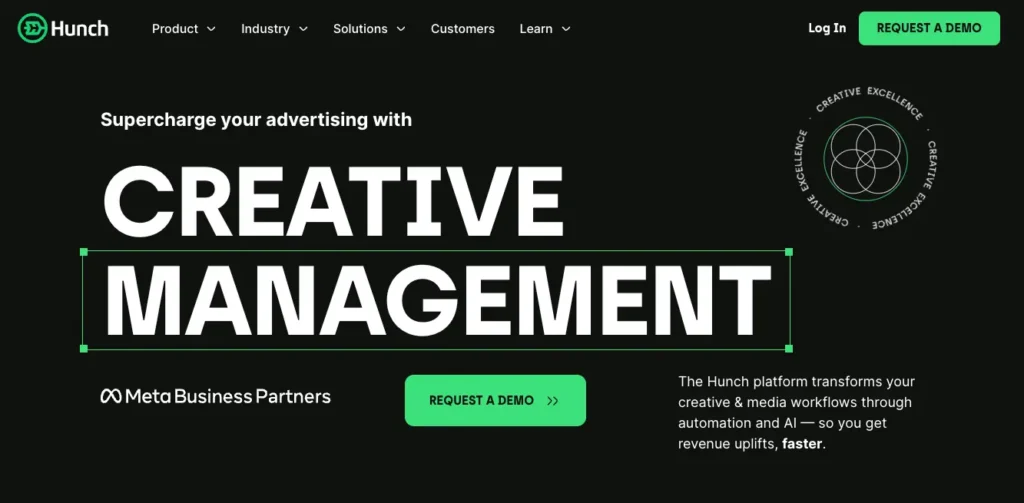
Source: hunchads.com
Hunch is a one-stop-shop for automating your creative production processes. Not only does this automation tool help you create tons of personalized templates from scratch, it also lets you import .psd files or choose a ready-made template for lightning-fast content creation.
The platform comes kitted out with a series of AI tools to suggest color palettes, remove unwanted elements, and more. But it doesn’t stop there.
Hunch also helps teams manage entire campaigns right there on the platform. So, it’s a great two-for-one tool for teams that need to create and launch dynamic ad campaigns.
2. Celtra
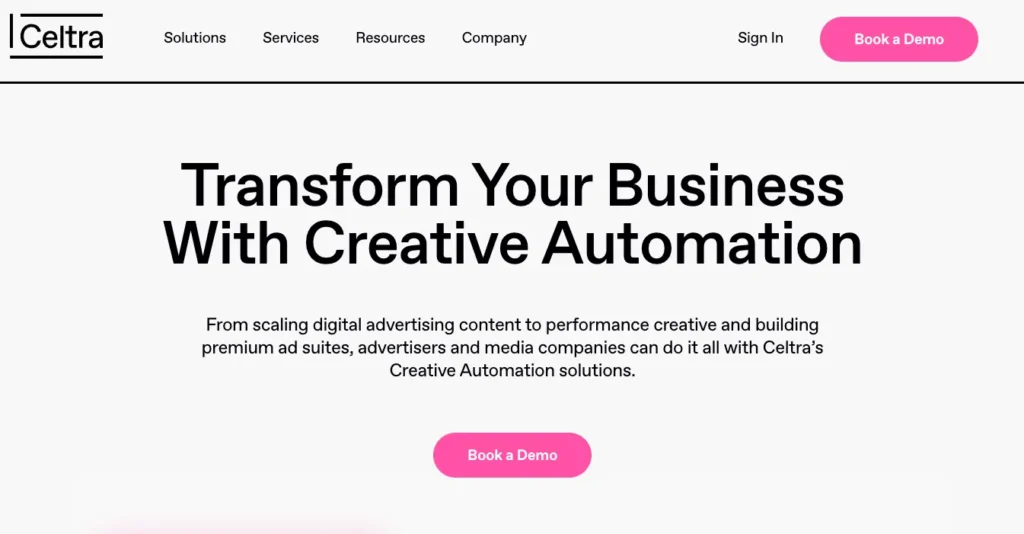
Source: celtra.com
Celtra is a creative automation platform with tools for designing, testing, and optimizing various types of content. This intuitive automation powerhouse specializes in helping brands turn initial concepts into stunning digital assets faster than ever. It supports multiple formats too, which makes it perfect for building large-scale campaigns and product ads.
Another perk that comes from working with Celtra is the fact that many of its features are similar to the tools most designers are already familiar with. So, teams can get stuck into creative automation without much of a learning curve.
3. Filestage
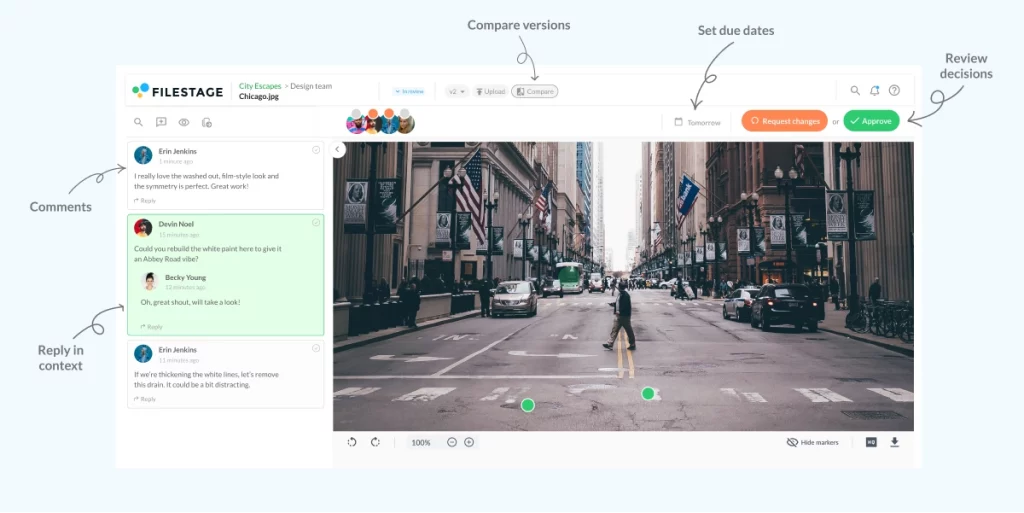
Creating high-quality content often involves gathering input from various team members and stakeholders. The trouble is, this process has the potential to be pretty time-consuming if not managed properly. So it’s a no-brainer to find yourself a solid review platform with some automations to speed things up along the way!
Filestage is a review and approval platform with lots of creative automation tools built in. It supports a range of file formats, including videos, images, PDFs, live websites, and HTML files. So, it’s the perfect tool for teams that want to use automation to speed up the way they review and approve creative content of any kind.
Speed up feedback across all your assets
Manage the review and approval of all your campaign content in one place.
4. Flaminjoy

Source: flaminjoy.com
Flaminjoy is a product experience management (PXM) platform that has a range of tools designed to tighten up the way teams produce and analyze content.
Social media content is Flaminjoy’s forte. Its creative automation features fuse AI with creativity to help teams make social media posts, paid and organic ads, and digital banners at scale. So if you’re in the business of managing multiple social channels, this might just be the tool for you!
With Flaminjoy, you can effortlessly generate numerous dynamic ad templates in minutes, tailoring them to suit your needs with a user-friendly drag-and-drop editor. As well as that, teams can use pre-built animation within the templates to animate static content to create tailored video ads. It’s ideal for optimizing enterprise workflow automation in creative teams.
5. Bannerflow

Source: bannerflow.com
Bannerflow is a creative automation tool built for designers, with a focus on ad creation and versioning.
With Bannerflow, users can create all kinds of display ads quickly and efficiently without the need for coding skills. The platform offers features like creative optimization, versioning, creative project management, and real-time collaboration. Together, these allow teams to streamline their workflow and improve the performance of their ad campaigns.
As well as creating and scaling quality designs, Bannerflow provides tools for A/B testing and analytics. It integrates with ad networks and social media platforms too, helping advertisers to level-up their campaign content as they go for better results.
6. Marpipe

Source: adexchanger.com
Knowing which kind of content works and why is super important for the success of your business’ creative operations. And Marpipe makes getting these insights a whole lot easier by automating the creative testing process.
Marpipe helps teams craft a winning content strategy by choosing designs based on the data it collects. The platform allows for fast A/B testing to identify the most impactful design elements and messaging strategies. It can even help you create different versions to test. All you have to do is upload your first set of creative assets, and then Marpipe can create a series of variations for you to test out. Taking the guesswork out of your creative approach has never been so easy!
7. Mailchimp
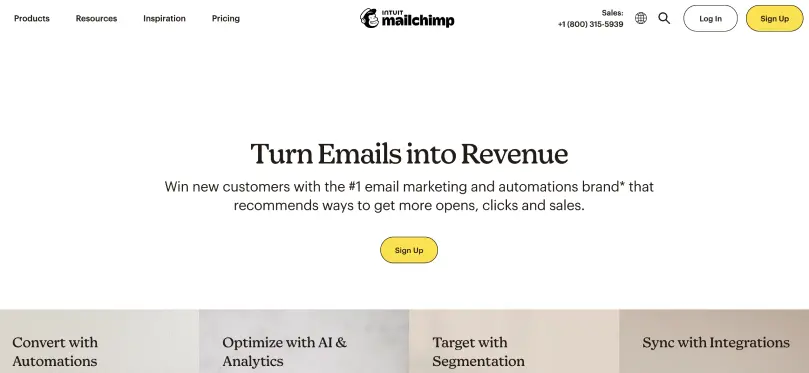
Source: mailchinp.com
There’s no need to monkey around (…) with your campaign workflow when you can use a tool like Mailchimp. This email marketing platform helps teams reach, engage, and convert more customers with its range of intuitive automation features.
With Mailchimp, you can create more relevant email campaigns that resonate more with your audience by segmenting your audience and tailoring content. The platform collects useful data on things like subscriber data, purchase history, preferences, and engagement level to help you make and deliver campaigns that hit the spot for your audience.
Mailchimp’s classic automation feature helps you streamline and schedule your communications to make sure your contacts get the right emails at the right time. You can choose from preset automations or completely customize your messaging.
8. Innervate

Source: innervate.com
Innervate is a customer experience platform that sets itself apart from other tools by focusing on automatic self-optimizing performance features and content production. This helps iron the kinks out of your creative process for faster, stronger results.
Innervate’s new Experience Automate solution has been designed to automate routine tasks in your experience management workflow, so teams can get on with the heavy-lifting in each project. From CX production and trafficking to reporting, iteration, and beyond, Experience Automate helps companies be more efficient, create memorable employee experiences, maka data-informed decisions, and more.
Innervate integrates with all the common channels and media platforms to streamline your CX management from start to finish.
9. Pixelixe

Source: pixelixe.com
Pixelixe is a graphic design tool that helps businesses create engaging graphics for every kind of asset.
This is a pretty comprehensive platform where teams can use templates (or start from scratch) to create banners, social media graphics, and email and blog images with its online image editor. It even gives users access to over 2,000,000 photos, 900 fonts, 700 icons, and photo filters.
The most notable thing about Pixelixe, for this article at least, is the tool’s automation feature that turns your creative ideas into templates and creates all the versions you need for different sizes and social media channels.
You can also use the Design Set Builder to create and edit designs which you can then apply to any or all of your assets as needed while ensuring brand consistency.
10. Bynder
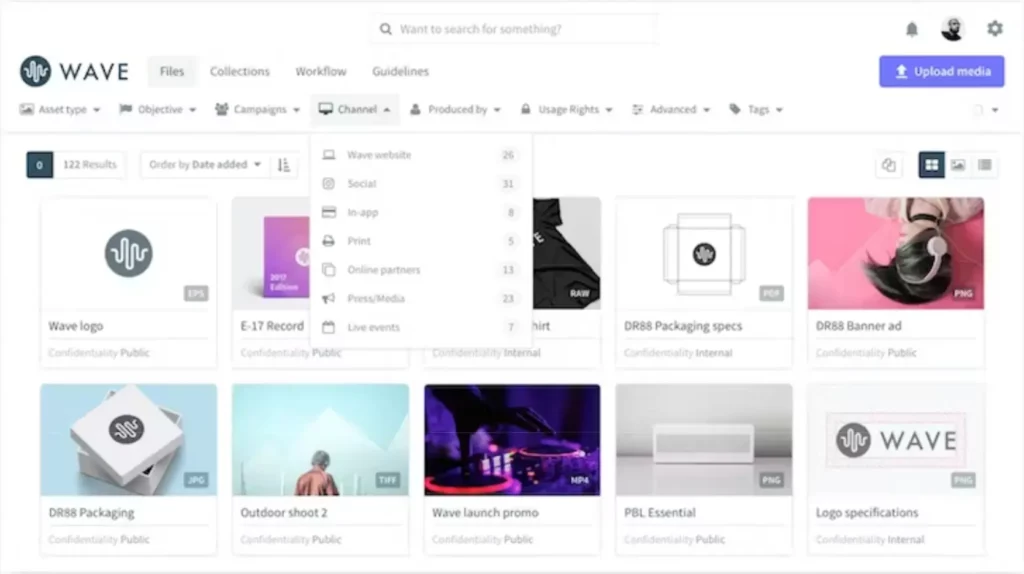
Source: bynder.com
Managing your creative assets for quick and easy access is another important part of the content production process. This is especially true for agencies and creative teams that need to create more and more content in a shorter time frame. And Bynder is one of the best DAM tools that uses automation and AI to streamline teams’ entire workflows.
Bynder is most known for its digital asset management capabilities, offering a robust platform for storing, sharing, and downloading files. What’s more, it has a powerful AI tool that can add information to assets with metadata for enhanced searchability, removing duplicate assets, and more. These slick features make all the difference for busy teams in a time crunch.
But Bynder’s use cases don’t stop there. Teams can also use the creative automation platform to automatically optimize assets, print brand templates, build a creative workflow, and scale and automate their digital content creation process. Ooft!
Final thoughts
All the leading creative automation tools in this article have been designed to boost productivity and efficiency. They cleverly automate routine tasks, using AI to speed up the way you create and deliver content.
So, whether you’re a content lead, brand manager, or creative director, there’s a good chance your team could benefit from creative automation in some shape or form. Just be sure to take the time to think about what you need from a creative automation platform to help you pick one that best suits your team’s requirements and ways of working.
I hope you found this article helpful. And if you’d like to see how Filestage can streamline your entire review process, start your free trial today.




